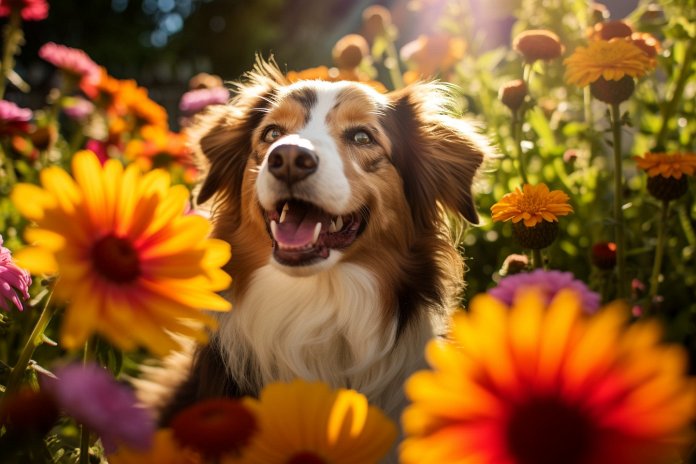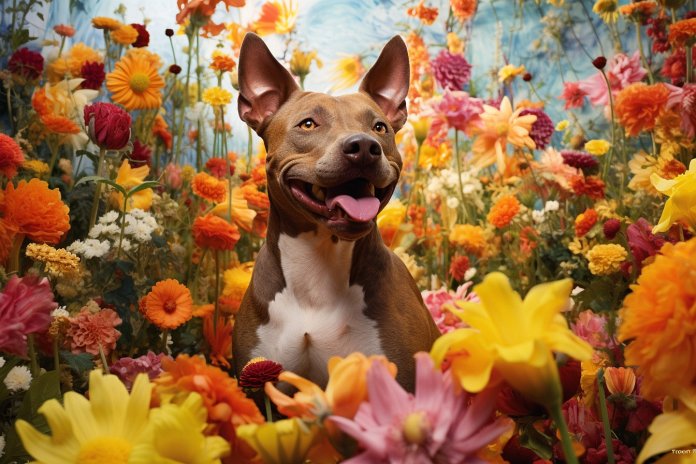
Spring flowers blooming after a cold winter are a beautiful sight. It makes walks more enjoyable and reminds us to stop and smell the roses. But can dogs smell flowers too? This raises questions about the effects of flowers on dogs. To better understand a dog’s sense of smell, we will explore their ability to smell flowers.
Signs Your Dog is Smelling a Flower
Yes, dogs can indeed smell flowers! With their powerful noses, it’s not surprising that they can even differentiate between different types of flowers. Some dogs may stop and sniff a flower in bloom, while others may not react at all. However, some dogs may mistake flowers for a quick bite. It’s important to be cautious because not all beautiful flowers are harmless. Ingesting or sniffing toxic flowers or plants can be dangerous.
If your dog ingests or sniffs a toxic flower or plant, they may exhibit various symptoms. These symptoms depend on the specific plant. Look out for the following behavioral signs:
– Head tilting:
If the toxin affects the dog’s nervous system, they may tilt their head, have difficulty standing or walking, and experience tremors.– Cowering:
Your dog may cower to signal that something is wrong. Pay attention to other signs if you notice this behavior.– Scratching:
Toxins that cause irritation in the mouth or nose may prompt your dog to scratch at their mouth as if trying to remove something.– Pacing:
Nervousness can be a result of an upset stomach or neurological issues.– Weakness:
Many plants cause vomiting and diarrhea, leading to loss of appetite and weakness.
Common symptoms of toxic plant ingestion in dogs include vomiting, diarrhea, changes in urine, and drooling.
It’s important to note that the bulb of a plant is often the most toxic part. If consumed, it can cause an upset stomach, stomach pain, and loss of appetite. This is especially concerning for dogs that like to dig, as sniffing closely at bulbs can still elicit a reaction. Plants that bloom or have berries often have higher concentrations of toxins.
Body Language
If your dog has gotten too close to a toxic flower, they may display the following signs:
– Head tilting
– Cowering
– Scratching
– Pacing
– Weakness
Other Signs
Other signs to watch out for are:
– Vomiting
– Loss of appetite
– Weakness
– Diarrhea
History of Dogs Sniffing Flowers
Historically, dogs were not as domesticated as they are today, so they did not stop to sniff flowers in the wild. However, during times when food was scarce, such as winter, dogs may have foraged for food in the form of plant bulbs. Unfortunately, this could lead to the accidental ingestion of poisonous plants or bulbs. There is no evidence to suggest that dogs will avoid certain plants because they know they are poisonous.
Science Behind Flower Toxicity to Dogs
Each toxic plant has its own specific symptoms depending on the type of toxin it contains. Some toxins cause irritation, while others can lead to bleeding disorders, neurological damage, or organ failure. Knowing which flowers are toxic to dogs is crucial for keeping your pet safe. Common flowers that pose a danger to dogs include Daffodils, Bishop’s Weed, Begonias, Tulips, Autumn Crocus, Azaleas, Sago Palms, Oleanders, and Amaryllis.
Training Dogs Around Plants
Dogs are naturally curious, especially when they are puppies. They may not just sniff an object but also try to nip it. This can be dangerous when it comes to poisonous plants and flowers. If you suspect your dog has ingested a toxic plant, do not take any action on your own. Immediately call a vet and seek professional help. Home remedies should not be attempted unless instructed by a vet.
The most common advice for pet poisoning by ingestion is to induce vomiting. However, this can sometimes worsen the situation, so it should only be done under veterinary supervision. To keep your pet safe, check all the plants in your garden and ensure they are safe for your dog. Before planting anything, research whether it is safe for your pet.
While simply sniffing plants is unlikely to be fatal, it is important to avoid any risks. If your dog persistently nips at plants, closely monitor their behavior in new parks and public spaces. Training them to avoid nipping or heeling on a lead can reduce the risk of them straying and ingesting something lethal.
“Protect your pooch’s sniffer: Recognize the signs and dangers of dogs sniffing flowers”

Tips & Things to Know
1️⃣ Be aware of the signs that your dog may be smelling a toxic flower. Look out for behaviors such as head tilting, cowering, scratching, pacing, and weakness. These signs can indicate that your dog has ingested or come into contact with a harmful plant.
2️⃣ Know which flowers are toxic to dogs. Some common toxic flowers include daffodils, tulips, azaleas, and oleanders. It’s important to keep your dog away from these plants to prevent any potential harm.
3️⃣ Take precautions to keep your dog safe around plants. Be vigilant when your dog is exploring new environments and make sure to have them under control at all times. Train your dog to avoid nipping or ingesting plants, and check the safety of the plants in your garden or other areas your dog can access. If you suspect your dog has ingested a toxic plant, contact a vet immediately and avoid attempting any home remedies without professional guidance.
Frequently Asked Questions, Answered ✅
1. Can dogs smell flowers?
– Yes, dogs have powerful noses and can smell flowers.
2. What are the signs that a dog has ingested a toxic flower?
– Signs include head tilting, cowering, scratching, pacing, weakness, vomiting, diarrhea, and loss of appetite.
3. What are some common flowers that are toxic to dogs?
– Some common toxic flowers include daffodils, tulips, azaleas, sago palms, oleanders, and amaryllis.
4. What should you do if you suspect your dog has ingested a toxic plant?
– Immediately call a vet and seek professional help. Do not try to induce vomiting or administer home medicine without professional guidance.
5. How can you train dogs to avoid nipping or ingesting toxic plants?
– Training dogs to avoid nipping or heeling on a lead in public spaces can reduce the risk of them straying and ingesting something lethal. Additionally, checking all plants in your garden and other accessible areas for toxicity before planting them can help keep your pet safe.